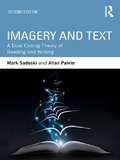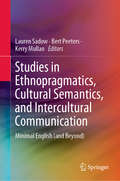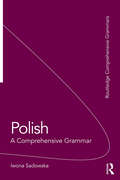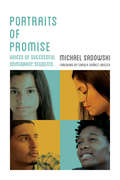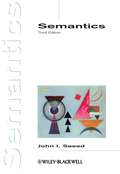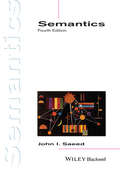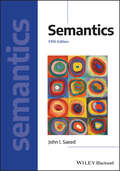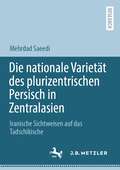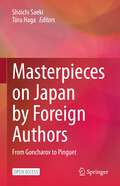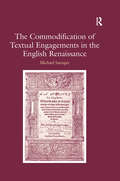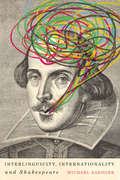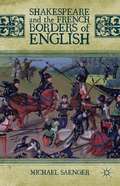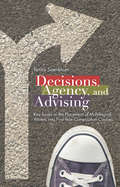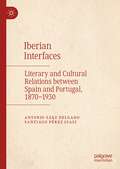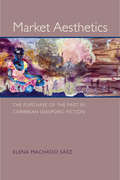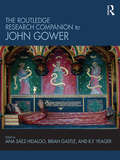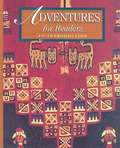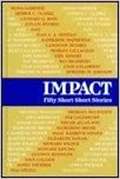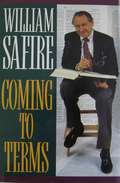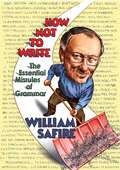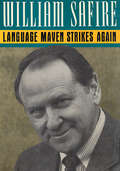- Table View
- List View
Imagery and Text: A Dual Coding Theory of Reading and Writing
by Mark Sadoski Allan PaivioImagery and Text, Second Edition extends the first edition’s unified theory of cognition in literacy from the perspective of Dual Coding Theory (DCT), one of the most influential and empirically sound theories of cognition ever developed. This theory provides a comprehensive, systematic account of all major aspects of literacy including decoding, comprehension, and response in reading and composing in writing. The Second Edition updates DCT as a scientific theory, a cognitive theory, an embodied theory, and a constructivist theory of literacy. New content includes a detailed account of the decoding process and its integral connection to comprehension, a new program of research on DCT in composing text, a review of neuroscientific support, and increased attention to multimedia literacy, socio-cultural influences, and recent educational applications. More than any other theory, DCT explains how both verbal and nonverbal cognition are woven together through all aspects of literacy. Written in concise chapters with illustrative examples, Imagery and Text is approachable for both students and advanced scholars in the field of literacy.
Studies in Ethnopragmatics, Cultural Semantics, and Intercultural Communication: Minimal English (and Beyond)
by Lauren Sadow Bert Peeters Kerry MullanThis book is the third in a three-volume set that celebrates the career and achievements of Cliff Goddard, a pioneer of the Natural Semantic Metalanguage approach in linguistics. This third volume explores the potential of Minimal English, a recent offshoot of the Natural Semantic Metalanguage, with special reference to its use in Language Teaching and Intercultural Communication.Often considered the most fully developed, comprehensive and practical approach to cross-linguistic and cross-cultural semantics, Natural Semantic Metalanguage is based on evidence that there is a small core of basic, universal meanings (semantic primes) that can be expressed in all languages. It has been used for linguistic and cultural analysis in such diverse fields as semantics, cross-cultural communication, language teaching, humour studies and applied linguistics, and has reached far beyond the boundaries of linguistics into ethnopsychology, anthropology, history, political science, the medical humanities and ethics.
Polish: A Comprehensive Grammar (Routledge Comprehensive Grammars)
by Iwona SadowskaPolish: A Comprehensive Grammar is a complete reference guide to the grammar system for intermediate to advanced learners of Polish. It presents an accessible and systematic description of the language, focusing on real patterns of use in contemporary Polish. The Grammar is a comprehensive work and an invaluable resource for students and anyone interested in linguistics and the way modern Polish works. Features include: coverage of all parts of speech full cross referencing well selected and illuminating examples. The book is organised in such a way to promote a thorough understanding of Polish at all levels of structure; the sound system, formation of word and phrases and sentence construction. It offers a stimulating analysis of the complexities of the language, providing clear explanations and examples of each point. Polish: A Comprehensive Grammar is the essential reference work on Polish grammar for all learners and users of the language.
Portraits of Promise: Voices of Successful Immigrant Students (Youth Development and Education Series)
by Michael SadowskiBy 2040, more than 30 percent of students in the United States will be immigrants or the children of immigrants. What factors can help these young people thrive in school, despite the many obstacles they face? And how can school staff best support immigrant students&’ academic and personal success? In Portraits of Promise, educators hear from the ultimate experts—successful newcomer students. Drawing on the students&’ own stories, the book highlights the kinds of support and resources that help students engage positively with school culture, establish supportive peer networks, form strong bonds with teachers, manage competing expectations from home and school, and navigate the challenges of high-stakes testing and the college application process.
Portraits of Promise: Voices of Successful Immigrant Students
by Michael Sadowski Carola Suárez-OrozcoBy 2040, more than 30 percent of students in the United States will be immigrants or the children of immigrants. What factors can help these young people thrive in school, despite the many obstacles they face? And how can school staff best support immigrant students' academic and personal success? In Portraits of Promise, educators hear from the ultimate experts--successful newcomer students. Drawing on the students' own stories, the book highlights the kinds of support and resources that help students engage positively with school culture, establish supportive peer networks, form strong bonds with teachers, manage competing expectations from home and school, and navigate the challenges of high-stakes testing and the college application process.
Semantics
by John I. SaeedThe third edition of this popular textbook provides an engaging and accessible introduction to semantics for students new to the field. Explores the basic concepts and methods of the field and discusses some of the most important contemporary lines of researchContains new solutions to chapter exercises in order to familiarize the student with the practice of semantic descriptionCompletely revised and updated to reflect recent theoretical developmentsIncludes new sections on classifiers and noun classes, as well as conceptual integration
Semantics (Introducing Linguistics #25)
by John I. SaeedRevised and updated to reflect recent theoretical developments in the field, Semantics, 4th Edition, presents an engaging and accessible introduction to the study of meaning in language for students new to the field of semantics. Covers all of the basic concepts and methods of the field of semantics, as well as some of the most important contemporary lines of research Features a series of new exercises, along with their solutions, that are arranged by level of difficulty Addresses componential theory, formal semantics, and cognitive semantics, the three main current theoretical approaches to semantics Includes revisions and updates that reflect the most recent theoretical developments
Semantics (Introducing Linguistics #25)
by John I. SaeedThe latest edition of the bestselling introduction to the field of linguistic semantics, updated throughout and featuring a wholly new chapter on inferential pragmatics Semantics, Fifth Edition, is a comprehensive and well-balanced introduction to the study of the communication of meaning in language. Assuming no previous background in semantics and limited familiarity with formal linguistics, this student-friendly textbook describes the concepts, theory, and study of semantics in an accessible and clear style. Concise chapters describe the role of semantics within contemporary linguistics, cover key topics in the analysis of word and sentence meaning, and review major semantic theories such as componential theory, formal semantics, and cognitive semantics. The updated fifth edition incorporates recent theoretical developments and important research in linguistic semantics, featuring an entirely new chapter examining the overlap between inferential pragmatics and Relevance Theory, truth-conditional meaning, and other traditional areas of semantics. Revised and expanded sections discuss the continuing growth and consolidation of cognitive semantics, various contextual features of language, conceptualization and categorization, and construal and perspective. This edition includes new exercises with solutions, up-to-date references to relevant literature, and additional examples with data from a wide range of different languages. Covers basic concepts and methods as well as key theoretical models, current lines of research, and important writers Explains general concepts in semantics before gradually moving to more advanced topics in semantic description and theoretical approaches Highlights the relation between cross-linguistic variation and language universals Provides students with the background necessary to understand more advanced and specialized primary semantics literature Includes a glossary of technical terms and numerous exercises arranged by level of difficulty Highlights the relationship between semantics and cross-linguistic variation, language universals, and pragmaticsWith detailed examples from a wide range of contexts and a wealth of practical exercises, Semantics, Fifth Edition, remains the perfect textbook for undergraduate students of linguistics, English language, applied linguistics, modern languages, and computer sciences.
Die nationale Varietät des plurizentrischen Persisch in Zentralasien: Iranische Sichtweisen auf das Tadschikische
by Mehrdad SaeediDer Gegenstand dieser Studie ist tadschikisches Persisch in Zentralasien aus der iranischen Sichtweise. Die persische Sprache gilt als prominenteste iranische Sprache in der indoeuropäischen Sprachfamilie mit einer über tausendjährigen Literaturgeschichte, und nach soziolinguistischen Maßstäben ist sie plurizentrisch, also in mehreren Ländern vorkommend. Im 20. Jahrhundert und von der Sowjet-Ära an gewann Zentralasien für die Entwicklung der persischen Sprache erneut an Relevanz, während traditionellerweise Iran — bis 1935 „Persien“ genannt — als dominantes Sprachzentrum des plurizentrischen Persisch betrachtet wurde und noch wird. Genau darin ist der Untersuchungsfokus dieser Arbeit begründet, nämlich: Wie nehmen die iranischen Sprecher und die Kultureliten Irans die Entwicklung, gar Abstandnahme einer sog. nationalen Varietät von anderen Varietäten ein und derselben Einzelsprache wahr?
Masterpieces on Japan by Foreign Authors: From Goncharov to Pinguet
by Shōichi Saeki Tōru HagaThis open access book includes forty-one chapters about foreign observers’ discourses on Japan. These include a wide range of perspectives from the travelogues of curious visitors to academic theses by scholars, which offer us a broad spectrum of contents, reflecting a variety of attitudes toward Japan. The works were written during the period from the 1850s to the 1980s, a timespan during which Japan became, in stages, more open to the outside world after a long isolation under the Tokugawa shogunate. From the perspective of “Japanology,” one can discern three distinct periods of rising interest in the country from abroad. The first tide of such interest came shortly after the opening of Japan, when various foreign travelers, including those who could not be included in this book, came over and wrote down their impressions of the country—which was, for them, a land of mystery and mystique, which had just opened its doors to them. The second wave arose at the beginning of the twentieth century, just after the Russo-Japanese War, when Japan again generated a remarkable surge of interest as a “miracle” in Asia that had pulled off the wondrous feat of defeating a white superpower. The third wave was more recent, which took place from the late 1960s to the 1980s, a period of high economic growth when the “miracle” of Japan’s remarkable economic recovery from the defeat of World War II attracted enthusiastic and curious attention from the outside world once again. It is not the intention of this book to directly highlight such historical transitions, but these forty-two brilliant mirrors (forty-one chapters, including forty-two discourses), even when looked in casually, provide us with unexpected insights and various perspectives. Shōichi Saeki (1922–2016) was Professor Emeritus, the University of Tokyo. Tōru Haga (1931–2020) was Professor Emeritus, International Research Center for Japanese Studies.
The Commodification of Textual Engagements in the English Renaissance
by Michael SaengerAn investigation into the ways in which early modern books were advertised, this study argues that those means of advertisement both record and help to shape social interactions between people and books. These interactions are not only fascinating in themselves, but also demonstrably linked to larger social phenomena, such as human commodification, the development of English nationalism, the increasingly unruly proliferation of literacy, and changing conceptions of literature. Within the context of recent developments of new textualism and new economic criticism, Saenger's approach makes use of formalist strategies of genre recognition as well as new historicist connections between social history and art. In this study Saenger illustrates his general account of the formal properties of front matter-titles and subtitles, prefatory epistles, and commendatory verses-with engaging readings of specific examples, including Feltham's Resolves, A Myrrovre for Magistrates, and Sidney's Arcadia. He explores the several ways in which paratextual authors sought to involve the reader in various active roles vis à vis the main text, whether those books were prose fiction or translated continental sermons. Some particular attention is devoted to printed drama, both because dramatic texts present printers with a unique set of challenges and because those texts have often been misread in recent criticism. This book offers a much-needed analysis of profound transformations-not only to the book trade as an industry, but also to the very concepts of reading and authorship-in an age which saw the relatively brief coincidence of ancient marketing strategies and systems and the burgeoning market of the mechanically reproduced text.
Interlinguicity, Internationality, and Shakespeare
by Michael SaengerLanguages have become more mobile than ever before, producing translations, transplantations, and cohabitations of all kinds. The early modern period also witnessed profound linguistic transformation, but in very different ways. Interlinguicity, Internationality, and Shakespeare undoes the illusion that Shakespeare wrote in what we now think of as English. In a series of essays approaching Shakespeare from unique and thought-provoking perspectives, contributors from history, performance criticism, and comparative literature look at "interlinguicity," the condition of being between languages, and "internationality," the condition of being between countries. Each essay focuses on local issues, such as community identification in the Netherlands of Shakespeare's time and the appropriation of Shakespeare in German literature in the nineteenth century, to suggest that Shakespeare never wrote "in" English because English was not then, nor is it now, an intact, knowable system. Many languages existed in sixteenth-century London, and English did not have clear limits. Interlinguicity, Internationality, and Shakespeare helps to explain the hybridity that Shakespeare embraced in all his writing. Contributors include Paula Blank (College of William and Mary), Lauren Coker (Saint Louis University), Brian Gingrich (Princeton University), Alexa Huang (George Washington University), James Loehlin (University of Texas at Austin), Scott Newstok (Rhodes College), Patricia Parker (Stanford University), Elizabeth Pentland (York University), Philip Schwyzer (University of Exeter), Gary Waite (University of New Brunswick), and Robert N. Watson (University of California, Los Angeles)
Shakespeare and the French Borders of English
by Michael SaengerThis study emerges from an interdisciplinary conversation about the theory of translation and the role of foreign language in fiction and society. By analyzing Shakespeare's treatment of France, Saenger interrogates the cognitive borders of England - a border that was more dependent on languages and ideas than it was on governments and shorelines.
Decisions, Agency, and Advising: Key Issues in the Placement of Multilingual Writers into First-Year Composition Courses
by Tanita SaenkhumDecisions, Agency, and Advising considers the role of students’ own agency in the placement of multilingual writers—including international students and US residents or citizens who are nonnative users of English—in US college composition programs. Grounded in qualitative research and concerned equally with theory and practice, the book explores how multilingual students exercise agency in their placement decisions and how student agency can inform the overall programmatic placement of multilingual students into first-year composition courses. Tanita Saenkhum follows eleven multilingual students who made their decisions about placement into first-year composition courses during one academic year at a large public university. She identifies the need for the process of making placement decisions to be understood more clearly, describes how to use that knowledge to improve placement practices for these students—particularly in advising—and offers hands-on recommendations for writing programs. Decisions, Agency, and Advising is a significant contribution to the field and particularly valuable to writing program administrators, academic advisors, writing teachers, researchers investigating second language writing and writing program administration, composition and second language writing scholars, and graduate students.
Iberian Interfaces: Literary and Cultural Relations between Spain and Portugal, 1870-1930
by Antonio Sáez Delgado Santiago Pérez IsasiThis book explores a key historical moment for literary and cultural relations between Spain and Portugal. Focusing on the period between 1870 and 1930, it analyses the contacts between Portuguese and Spanish writers and artists of this period, showing that, at least among the cultural elites, there were intense and fruitful dialogues across political and linguistic borders. The book presents the Iberian Peninsula as a complex and multilingual cultural polysystem in which diverse literary cultures coexist and are mutually dependent upon each other. It offers a panoramic view of Iberian literary and cultural history, encompassing not just Portuguese and Spanish literary productions, but also Catalan, Galician and Basque works. Combining a clear theoretical foundation with deep historical knowledge and references to specific texts and works, the book offers a thorough introduction to Iberian literature in the late nineteenth and early twentieth century.
Market Aesthetics: The Purchase of the Past in Caribbean Diasporic Fiction (New World Studies)
by Elena Machado SáezIn Market Aesthetics, Elena Machado Sáez explores the popularity of Caribbean diasporic writing within an interdisciplinary, comparative, and pan-ethnic framework. She contests established readings of authors such as Junot Díaz, Julia Alvarez, Edwidge Danticat, and Robert Antoni while showcasing the work of emerging writers such as David Chariandy, Marlon James, and Monique Roffey. By reading these writers as part of a transnational literary trend rather than within isolated national ethnic traditions, the author is able to show how this fiction adopts market aesthetics to engage the mixed blessings of multiculturalism and globalization via the themes of gender and sexuality. New World Studies Modern Language Initiative
The Routledge Research Companion to John Gower
by Ana Saez-Hidalgo Brian Gastle R. F. YeagerThe Routledge Research Companion to John Gower reviews the most current scholarship on the late medieval poet and opens doors purposefully to research areas of the future. It is divided into three parts. The first part, "Working theories: medieval and modern," is devoted to the main theoretical aspects that frame Gower’s work, ranging from his use of medieval law, rhetoric, theology, and religious attitudes, to approaches incorporating gender and queer studies. The second part, "Things and places: material cultures," examines the cultural locations of the author, not only from geographical and political perspectives, or in scientific and economic context, but also in the transmission of his poetry through the materiality of the text and its reception. "Polyvocality: text and language," the third part, focuses on Gower’s trilingualism, his approach to history, and narratological and intertextual aspects of his works. The Routledge Research Companion to John Gower is an essential resource for scholars and students of Gower and of Middle English literature, history, and culture generally.
Adventures For Readers: An Introduction (Athena Edition) (Adventures In Literature)
by SafierAdventures For Readers, Adventures In Literature (Athena Edition)
Adventures For Readers, Book Two: Athena Edition
by SafierSequentially outlays poems, short stories, plays plus other literary works as it challenges the minds of the readers to carefully determine the main idea of the selection and exactly what the writer's aim was without having to directly derive from it. It aims at making skilled readers from most readers.
Adventures in Reading (Pegasus Edition)
by Fannie Safier Margaret Ferry Wanda SchindleyLiterature textbook.
COMING TO TERMS
by William SafireWhen William Safire delineates the difference between misinformation and disinformation or "distances himself" from clichés, people sit up and take notice. Which is not to say that Safire's readers always take the punning pundit at his word: they don't, and he's got the letters to prove it. Among the entries in Coming to Terms, this all-new collection of Safire's "On Language" columns, you'll read the repartee of Lexicographic Irregulars great and small. John Haim of New York sets in concrete what properly to call a cement truck, while Charlton Heston challenges an interpretation of Hamlet's "to take arms against a sea of troubles" and Gene Shalit passes along his favorite Yogi Berra-ism. Bringing them all together are dozens of Safire's most illuminating and witty columns, from "Right Stuffing" to "Getting Whom." When William Safire comes to terms, there's never a dull moment.
How Not to Write: The Essential Misrules of Grammar
by William SafireThese fifty humorous misrules of grammar will open the eyes of writers of all levels to fine style. How Not to Write is a wickedly witty book about grammar, usage, and style. William Safire, the author of the New York Times Magazine column "On Language," homes in on the "essential misrules of grammar," those mistakes that call attention to the major rules and regulations of writing. He tells you the correct way to write and then tells you when it is all right to break the rules. In this lighthearted guide, he chooses the most common and perplexing concerns of writers new and old. Each mini-chapter starts by stating a misrule like "Don't use Capital letters without good REASON." Safire then follows up with solid and entertaining advice on language, grammar, and life. He covers a vast territory from capitalization, split infinitives (it turns out you can split one if done meaningfully), run-on sentences, and semi-colons to contractions, the double negative, dangling participles, and even onomatopoeia. Originally published under the title Fumblerules.
In Love with Norma Loquendi
by William SafireThe Pulitzer Prize-winning columnist describes his lifelong fascination with Norma Loquendi--common speech--in a collection of columns that celebrates the mysteries and continual evolution of the English language.From the Hardcover edition.
Language Maven Strikes Again
by William SafireA sixth collection of his syndicated "On Language" columns.
